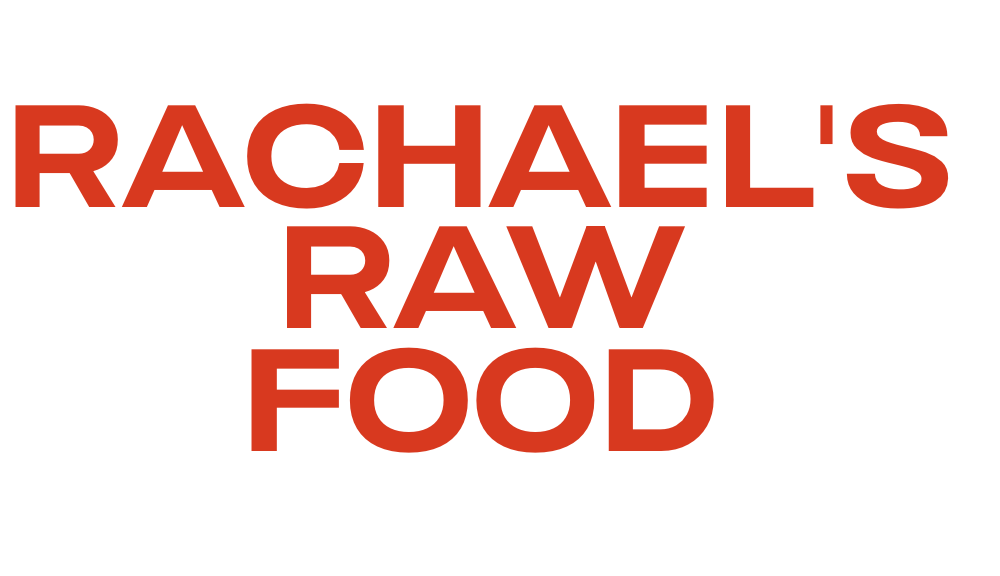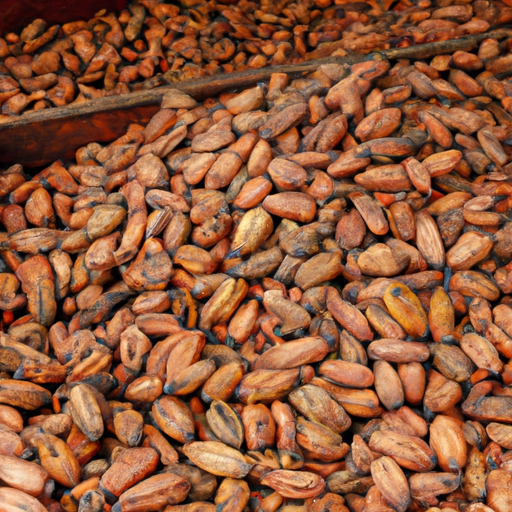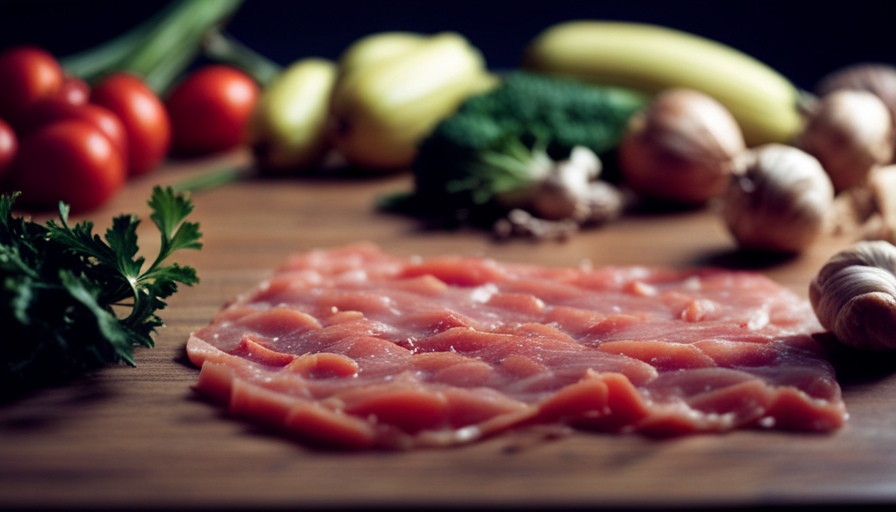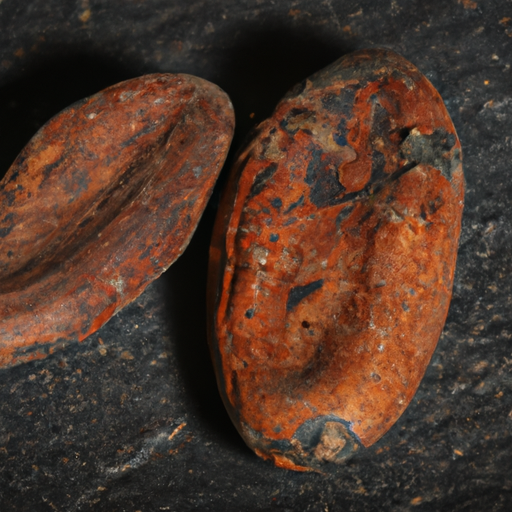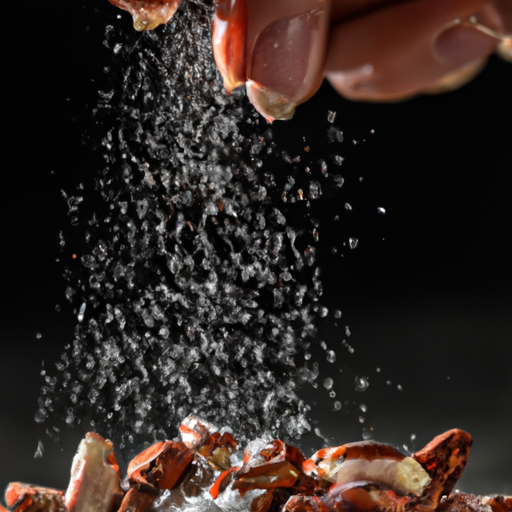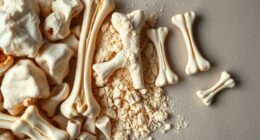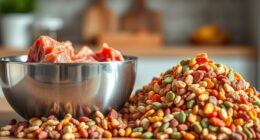I’ve always been captivated by the enchanting metamorphosis that occurs when raw cacao is transformed into delectable chocolate. It’s like watching a simple bean become a heavenly delight that excites the senses. In this article, we’ll explore the complex process of raw cacao processing and reveal the mysteries behind its delicious transformation.
The process begins with the harvesting of cacao pods, which are carefully plucked from the trees. The beans inside these pods then undergo fermentation, drying, and sorting to enhance their flavor and remove any impurities.
Next, the beans are roasted to develop their rich aroma and deep flavors. After roasting, the cacao beans are ground into nibs, which are further processed into a smooth and velvety cacao liquor.
But the journey doesn’t end there. The chocolate undergoes a process called conching and refining, where it is meticulously blended and smoothed to achieve the perfect texture.
Finally, the chocolate is tempered, molded into bars, and carefully packaged, ready to be savored by chocolate enthusiasts like myself.
So, let’s embark on this enlightening journey together and explore the intricate art of raw cacao processing.
Key Takeaways
- Raw cacao is harvested from cacao pods and undergoes fermentation, drying, sorting, and roasting.
- Fermentation enhances flavor and aroma, while drying reduces moisture content and prevents mold or bacteria growth.
- Roasting develops flavors, reduces bitterness, and triggers the Maillard reaction.
- The processed cacao is then pressed to separate solids and butter, and conching is performed to develop desired flavor profiles.
The Harvesting of Cacao Pods
The process of harvesting cacao pods is a truly labor-intensive and awe-inspiring task. Cacao pod harvesting techniques vary depending on the region and the specific methods employed by farmers.
Typically, the pods are carefully cut from the cacao trees using machetes or specialized tools. It requires precision and skill to ensure that the pods are not damaged during the harvesting process.
However, the environmental impact of cacao pod harvesting can be significant. Clearing land for cacao plantations can lead to deforestation and loss of biodiversity. Additionally, the use of pesticides and fertilizers in conventional farming practices can have detrimental effects on the surrounding ecosystems.
Transitioning into the subsequent section about fermentation of cacao beans, it is crucial to understand that the harvesting of cacao pods is just the first step in a complex process that transforms raw cacao into the delicious chocolate we all love.
Fermentation of Cacao Beans
During fermentation, cacao beans undergo a natural transformation that enhances their flavor and aroma. This crucial step in the processing of raw cacao involves the breakdown of complex compounds and the development of desirable flavors.
Here are three important aspects of fermentation techniques that contribute to the quality of cacao beans:
-
Microbial Action: Fermentation relies on microorganisms present on the cacao beans and in the environment to initiate and facilitate the fermentation process. These microorganisms metabolize the sugars in the beans, generating heat and producing byproducts that influence the flavor profile.
-
Temperature Control: The temperature during fermentation is carefully regulated to ensure optimal conditions for the desired microbial activity. This control helps achieve consistent flavor development and prevents off-flavors from forming.
-
Duration: The duration of fermentation varies depending on the desired flavor profile. Shorter fermentation times result in fruity and acidic flavors, while longer fermentation times produce deeper, richer flavors.
Fermentation plays a crucial role in shaping the flavor profiles of cacao beans before they proceed to the next step of drying and sorting.
Drying and Sorting the Cacao Beans
After fermentation, the next step in the process is to dry and sort the cacao beans. This crucial step ensures that the beans are properly prepared for further processing in chocolate production.
Drying the beans is essential as it reduces the moisture content and prevents the growth of mold or bacteria. The beans are usually spread out in thin layers and exposed to sunlight or hot air in order to facilitate the drying process. This can take anywhere from a few days to a week, depending on the climate and the desired moisture level.
Once the beans are dry, they are sorted based on quality and size. This involves removing any defective or discolored beans to ensure a consistent flavor in the final product.
After the drying and sorting process, the cacao beans are ready for the next stage: roasting.
In the subsequent section about ‘roasting the cacao beans’, the dried and sorted cacao beans undergo a crucial transformation that brings out their distinct flavors and aromas.
Roasting the Cacao Beans
Get ready to experience the mouthwatering transformation that occurs when we roast those carefully dried and sorted cacao beans! Roasting is a crucial step in the processing of raw cacao, as it develops the distinct flavors we associate with chocolate. The roasting techniques employed greatly impact the final flavor profile of the cacao beans.
Here are four key ways in which roasting affects the taste of chocolate:
-
Flavor Development: Roasting brings out the complex flavors hidden within the cacao beans, enhancing the natural fruity, nutty, and floral notes.
-
Aroma Enhancement: The heat of roasting intensifies the aroma of the beans, creating a tantalizing scent that entices the senses.
-
Reduction of Bitterness: Carefully controlled roasting helps eliminate the inherent bitterness of raw cacao, resulting in a more balanced and enjoyable flavor.
-
Maillard Reaction: Roasting triggers the Maillard reaction, a chemical process that creates delicious caramelization and browning, adding depth and richness to the chocolate.
Now, let’s delve into the next step of the process: grinding the cacao nibs.
Grinding the Cacao Nibs
Now, it’s time to take those tantalizingly roasted cacao beans and transform them into delectable chocolate by grinding the gorgeous cacao nibs! Grinding the cacao nibs is a crucial step in the process of making raw cacao. It involves breaking down the nibs into a fine paste or powder, which can then be used to create a variety of chocolate products. There are different techniques for grinding cacao nibs, including using a stone grinder or a high-speed blender. These methods ensure that the nibs are finely ground, releasing their rich flavors and aromas. The benefits of grinding cacao nibs are twofold. Firstly, it helps to improve the texture of the chocolate, making it smooth and velvety. Secondly, it enhances the flavor by releasing the natural oils and intensifying the taste. By grinding the cacao nibs, we are one step closer to creating the luscious cacao liquor that will be used to make our chocolate bars.
Pressing the Cacao Liquor
After grinding the cacao nibs, the resulting paste, known as cacao liquor, undergoes a pressing process. This step is crucial in separating the cacao solids from the cacao butter.
Various techniques can be employed to press the cacao liquor, each resulting in different flavor variations. The most common method involves using a hydraulic press to exert pressure on the liquor contained within filter bags. This process helps to extract the cacao butter, leaving behind a cake-like substance called ‘press cake.’
The cacao butter is collected and can be used for other purposes, such as making chocolate bars or cocoa butter products. The remaining press cake is further processed to create cocoa powder.
Pressing the cacao liquor is an essential step in the chocolate-making process, as it helps to refine the flavors and textures of the final product.
Now, let’s delve into the next stage of chocolate production: conching and refining the chocolate.
Conching and Refining the Chocolate
To create the smooth and velvety texture that you love in chocolate, the next step is conching and refining the mixture. Conching is a process that involves mixing and kneading the chocolate mass for several hours, which helps in developing the desired chocolate flavor profiles. There are different conching techniques, such as the Long Conching method, which takes around 72 hours, and the Short Conching method, which takes about 6 to 12 hours.
During this process, the chocolate undergoes intense shearing and friction, resulting in the reduction of particle size and the smoothness of the chocolate. Refining, on the other hand, involves further grinding the chocolate particles to achieve a finer texture. This step is crucial for removing any remaining grittiness and improving the overall mouthfeel.
Moving on to the subsequent section about tempering the chocolate, it is important to ensure the final product has a glossy appearance and a firm texture.
Tempering the Chocolate
Tempering chocolate is necessary to achieve a glossy appearance and firm texture. It ensures the final product has a smooth and shiny finish, a satisfying snap, and a longer shelf life. Tempering stabilizes the cocoa butter crystals, preventing the formation of a dull and grainy texture. It gives the chocolate a desirable sheen and a pleasant mouthfeel.
There are several effective techniques for tempering chocolate, including seeding, tabling, and using tempering machines. Each method involves carefully controlling the temperature at which the chocolate is heated, cooled, and reheated. These techniques optimize the formation of the desired cocoa butter crystals.
With the chocolate perfectly tempered, it is now ready for the next step in the process: molding and packaging the chocolate bars.
Molding and Packaging the Chocolate Bars
Once you have successfully tempered the chocolate, you can move on to molding and packaging the delectable chocolate bars. Molding techniques play a crucial role in creating the desired shape and texture of the final product. The process involves pouring the tempered chocolate into molds and allowing it to cool and harden. Different molds can be used to create various shapes and sizes of chocolate bars, from classic rectangular bars to intricate designs.
In addition to molding, packaging the chocolate bars is equally important. Sustainable packaging options have gained popularity in recent years, as consumers become more conscious of the environmental impact of their choices. Companies now offer packaging made from recycled materials or biodegradable alternatives. These sustainable options not only reduce waste but also contribute to the overall appeal of the product. Proper packaging ensures the chocolate bars remain fresh and protected during transportation and storage, allowing customers to enjoy the rich flavors and smooth textures that come from perfectly molded chocolate bars.
Frequently Asked Questions
How long does it take for cacao pods to mature and be ready for harvesting?
Cacao pods typically take around 4 to 5 months to mature and become ready for harvesting. This ensures optimal flavor and quality. The harvesting schedule is crucial in determining the peak ripeness and sweetness of the pods.
What are the different factors that affect the quality of cacao beans during fermentation?
Factors affecting fermentation quality include temperature, duration, and oxygen levels. Proper fermentation techniques are crucial to develop desired flavors and remove bitterness. Controlling these factors ensures optimal fermentation, resulting in high-quality cacao beans for further processing.
How are cacao beans dried and sorted after fermentation?
After fermentation, cacao beans are dried using various methods such as sun drying or mechanical drying. The beans are then sorted by size, quality, and defects. The drying process removes moisture, while the sorting process ensures only the best beans are used.
What is the ideal temperature and duration for roasting cacao beans?
The ideal temperature for roasting cacao beans is around 250 to 280 degrees Celsius, and the recommended roasting duration is typically between 20 to 30 minutes. These parameters ensure the desired flavor and aroma development in the beans.
What techniques are used for grinding cacao nibs into a fine powder?
To grind cacao nibs into a fine powder, I use a technique called milling. This involves using specialized equipment such as a grinder or a food processor. These machines help break down the nibs into a smooth, powdery consistency.
What is the Processing Difference Between Raw Cacao and Cacao Tea?
When making raw cacao tea, the processing of raw cacao involves fermenting and roasting the cacao beans at high temperatures, which results in the breakdown of some of the nutrients and antioxidants. Cacao tea, on the other hand, is made from the husks of the cacao bean, which are not fermented or roasted, thus retaining more of the natural nutrients and antioxidants.
Conclusion
In conclusion, the process of raw cacao processing is a meticulous and intricate one. Every step requires precision and expertise, from the harvesting of cacao pods to the molding and packaging of chocolate bars.
The journey begins with the harvesting of cacao pods, which are carefully cut from the trees by skilled workers. Once the pods are collected, they are opened to reveal the precious cacao beans inside.
The beans are then fermented, a crucial step that brings out the complex flavors of the cacao. The fermentation process can take several days and requires careful monitoring to ensure optimal results.
After fermentation, the beans are dried to reduce their moisture content. This can be done naturally under the sun or using specialized drying equipment. Once dried, the beans are ready for the next stage of processing.
The dried beans are roasted to further develop their flavors and remove any remaining moisture. The roasting temperature and time are carefully controlled to achieve the desired taste profile.
Once roasted, the beans are cracked and winnowed to remove the outer shell, known as the husk. This process separates the cacao nibs, which are the essence of raw cacao, from the husk.
The cacao nibs are then ground into a paste called chocolate liquor. This paste can be further processed to separate the cocoa solids from the cocoa butter, or it can be used as is to make chocolate.
Finally, the chocolate liquor is tempered and molded into the desired shape, whether it be bars, truffles, or other confections. The molded chocolate is then cooled and packaged, ready to be enjoyed by chocolate lovers around the world.
As the saying goes, ‘The proof of the pudding is in the eating,’ and this rings true for chocolate lovers who can appreciate the artistry and science behind raw cacao processing. So next time you indulge in a delicious chocolate bar, remember the journey it took from bean to bar.
